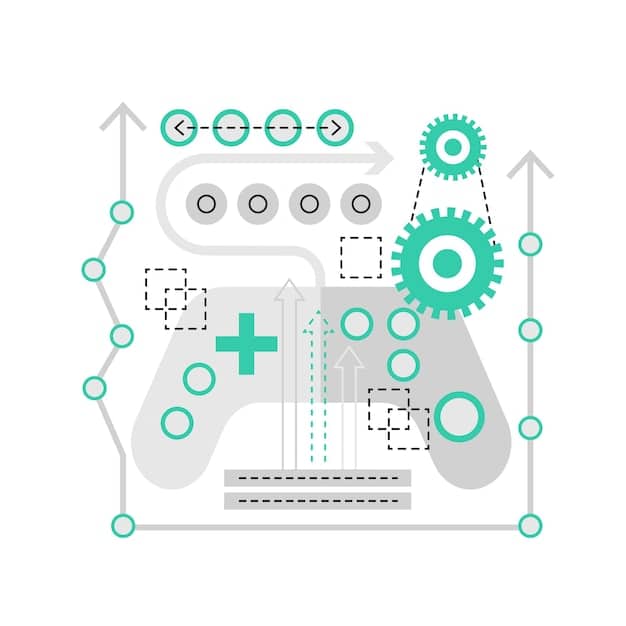Next-Gen Console Controllers: Features & Customization Options

Next-Gen Console Controllers: Exploring the Latest Features and Customization Options encompasses a new era of gaming peripherals designed to enhance user experience through advanced technology and personalization, including haptic feedback, adaptive triggers, and extensive customization.
Dive into the world of Next-Gen Console Controllers: Exploring the Latest Features and Customization Options, where innovation meets immersive gameplay. Discover how these cutting-edge devices are revolutionizing the gaming experience.
Exploring the Evolution of Console Controllers
Console controllers have come a long way since their inception. From simple joysticks to sophisticated devices with advanced features, the evolution of controllers has significantly impacted how we interact with games.
The latest generation of console controllers introduces features designed to provide a more immersive and personalized gaming experience. These innovations include haptic feedback, adaptive triggers, and enhanced customization options.
Brief History of Console Controllers
The journey of console controllers began with basic directional pads and buttons, gradually evolving to include analog sticks and more complex layouts. Each iteration aimed to improve precision and comfort.
Key Innovations in Controller Technology
Significant innovations, such as rumble feedback, motion sensing, and wireless connectivity, have transformed controllers into versatile and immersive gaming tools.
- Rumble Feedback: Enhances immersion by providing tactile sensations based on in-game events.
- Motion Sensing: Allows players to control games through physical movements.
- Wireless Connectivity: Offers freedom of movement without the constraints of cables.
- Adaptive Triggers: Adjust the resistance and tension of the triggers, providing nuanced feedback.

The evolution of console controllers reflects a continuous pursuit of enhanced user experience and deeper immersion. With each generation, new features and technologies aim to bridge the gap between the player and the game world, providing more intuitive and engaging ways to interact with virtual environments.
Haptic Feedback: Feel the Game
Haptic feedback is one of the most significant advancements in next-gen console controllers. It allows players to feel tactile sensations that correspond to in-game events, enhancing immersion and realism.
This technology goes beyond simple vibrations, offering nuanced and precise feedback that can simulate a wide range of textures and sensations, making the gaming experience more engaging.
How Haptic Feedback Works
Haptic feedback utilizes advanced actuators to create detailed and realistic sensations. These actuators can simulate everything from the subtle texture of sand to the impact of a collision.
Benefits of Haptic Feedback in Gaming
Haptic feedback enhances immersion by providing tactile cues that correspond to in-game events. This can improve a player’s sense of presence and connection to the game world.
- Enhanced Immersion: Players can feel the texture of different surfaces and the impact of actions.
- Improved Realism: Tactile sensations make in-game events feel more realistic and visceral.
- Increased Engagement: Haptic feedback keeps players more engaged and attentive.
Haptic feedback is revolutionizing the way players experience games, adding a new layer of depth and realism. By providing tactile sensations that correspond to in-game events, haptic feedback enhances immersion and provides a more engaging and visceral gaming experience.
Adaptive Triggers: Dynamic Resistance and Tension
Adaptive triggers are another groundbreaking feature in next-gen console controllers. They provide dynamic resistance and tension, allowing developers to simulate a variety of actions and sensations with unparalleled realism.
This technology enables players to feel the difference between firing a bow and arrow versus firing a machine gun, adding a new layer of tactile depth to gameplay.
How Adaptive Triggers Work
Adaptive triggers use motorized mechanisms to adjust the resistance and tension of the triggers. This allows developers to map specific actions to the triggers, providing nuanced feedback to the player.
Advantages of Adaptive Triggers in Games
Adaptive triggers can significantly enhance the gaming experience by providing tactile feedback that corresponds to in-game actions. This makes gameplay more immersive and engaging.
- Realistic Sensations: Players can feel the tension of drawing a bow or the resistance of a brake pedal.
- Enhanced Control: Adaptive triggers provide more precise control over in-game actions.
- Deeper Immersion: Tactile feedback enhances the sense of presence in the game world.

Adaptive triggers are transforming the way players interact with games, adding a new dimension of tactile feedback and control. By providing dynamic resistance and tension, these triggers make gameplay more immersive, realistic, and engaging.
Customization Options: Make It Your Own
Next-gen console controllers offer extensive customization options, allowing players to personalize their gaming experience. From button mapping to custom profiles, these features enable players to tailor their controllers to their specific preferences and playstyles.
Customization is not just about aesthetics; it’s about creating a controller that feels like an extension of the player, enhancing comfort and performance.
Personalizing Your Controller
Players can customize their controllers through various software and hardware options. Button mapping, sensitivity adjustments, and custom profiles are just a few of the ways to personalize the gaming experience.
Benefits of Customization
Customization enhances comfort and performance by allowing players to tailor their controllers to their specific needs. This can lead to improved accuracy and more enjoyable gameplay.
- Improved Comfort: Adjust the controller layout to fit your hand size and grip.
- Enhanced Performance: Optimize sensitivity and button mapping for your playstyle.
- Greater Personalization: Create custom profiles for different games and scenarios.
Customization empowers players to create controllers that reflect their unique preferences and playstyles. By offering a wide range of personalization options, next-gen console controllers enhance comfort, performance, and overall gaming enjoyment.
Ergonomics and Comfort: Long Gaming Sessions
Ergonomics and comfort are crucial factors in the design of next-gen console controllers. These controllers are designed to fit comfortably in the hands, reducing strain and fatigue during long gaming sessions.
Improved ergonomics not only enhance comfort but also contribute to better performance. A comfortable controller allows players to focus on the game without being distracted by discomfort.
Ergonomic Design Principles
Ergonomic design focuses on creating controllers that fit the natural contours of the hands. This involves careful consideration of grip size, button placement, and overall shape.
Features That Enhance Comfort
Features such as textured grips, contoured shapes, and adjustable weight contribute to the overall comfort of next-gen console controllers.
- Textured Grips: Provide a secure and comfortable hold, even during intense gameplay.
- Contoured Shapes: Fit the natural curves of the hands, reducing strain and fatigue.
- Adjustable Weight: Allow players to customize the weight of the controller to their preference.
Ergonomics and comfort are paramount in the design of next-gen console controllers. By prioritizing these factors, manufacturers create controllers that enhance the overall gaming experience, allowing players to enjoy long gaming sessions without discomfort or fatigue.
Connectivity and Compatibility: Seamless Gaming
Connectivity and compatibility are essential features of next-gen console controllers. These controllers are designed to seamlessly connect to a variety of devices, ensuring a smooth and hassle-free gaming experience.
Whether playing on a console, PC, or mobile device, next-gen controllers offer versatile connectivity options and broad compatibility.
Wireless and Wired Options
Next-gen controllers offer both wireless and wired connectivity options, providing flexibility for different gaming setups. Wireless connectivity allows for freedom of movement, while wired connections ensure low latency and reliable performance.
Device Compatibility
Next-gen controllers are compatible with a wide range of devices, including consoles, PCs, and mobile devices. This allows players to use their favorite controller across multiple platforms.
- Consoles: Seamless integration with next-gen consoles for optimized performance.
- PCs: Broad compatibility with Windows and other operating systems.
- Mobile Devices: Support for Bluetooth connectivity for gaming on smartphones and tablets.
Connectivity and compatibility are key features of next-gen console controllers, ensuring a seamless and versatile gaming experience. Whether playing on a console, PC, or mobile device, these controllers offer the flexibility and reliability needed for enjoyable gameplay.
| Key Feature | Brief Description |
|---|---|
| 🎮 Haptic Feedback | Provides tactile sensations that match in-game events. |
| ⚙️ Adaptive Triggers | Offers dynamic resistance and tension for realistic sensations. |
| 🎨 Customization | Allows players to personalize button mapping and profiles. |
| 💪 Ergonomics | Designed for comfort during long gaming sessions. |
Frequently Asked Questions
▼
Haptic feedback is an advanced tactile technology that simulates the sense of touch. It provides players with detailed and realistic sensations corresponding to in-game events, enhancing immersion.
▼
Adaptive triggers offer dynamic resistance and tension, allowing players to feel the difference between various actions. For instance, the trigger could resist more when pulling a virtual bowstring in-game.
▼
Customization options typically include button mapping, sensitivity adjustments, and personalized profiles. This allows players to tailor their controller settings to suit their individual gaming preferences.
▼
Next-gen controllers generally support multiple platforms, including consoles, PCs, and mobile devices. However, compatibility can vary by controller model and may require specific drivers or software.
▼
Ergonomic designs prioritize comfort, reducing strain and fatigue during long gaming sessions. Controllers contoured to fit the hands enhance performance and ensure enjoyable gameplay for extended periods.
Conclusion
The world of Next-Gen Console Controllers: Exploring the Latest Features and Customization Options is continually evolving, with new innovations promising to elevate the gaming experience. From haptic feedback and adaptive triggers to extensive customization options, these controllers offer unparalleled levels of immersion, comfort, and personalization, transforming the way we interact with our favorite games.





